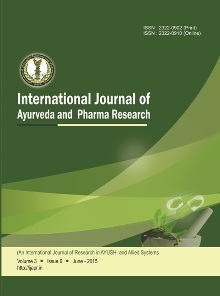Literature Review of Shati in Various Ayurvedic Treatise
Abstract
Hedychium spicatum Ham.ex Smith, commonly known as Kapur Kachari or Shati is one of the highly valued rhizomatous herb useful in a wide range of diseases. The rhizomes of this plant give a stimulant effect on the respiratory system. In Ayurveda it is considered as a potent herb to cure diseases like cough, symptoms of cold, asthma, bronchitis. It is placed under Hikka Nigrahan and Swashara Gana. The Guṇa-Karma of Shati included Laghu, Teeksṇa, Guṇa; Kaṭu, Tikta, Kaṣhaya Rasa; Anushṇa Veerya. Shati was found to be as the ingredient of many formulations like Chawanprasha, Agastya Haritaki Rasayana, Mahamayur Ghrit and Sudarshana Churna and used in the treatment of cough, hiccough, fever and asthma and other respiratory problems. The rhizomes are considered useful as stomachic, carminative and stimulant for the treatment of liver disorders, food poisoning, inflammation, asthma pain, bronchitis and brain tonic. Various Paryaya, Guna, Karma and different opinions of Acharyas from various Samhitas were observed.
Copyright (c) 2025 International Journal of Ayurveda and Pharma Research

This work is licensed under a Creative Commons Attribution-NonCommercial-ShareAlike 4.0 International License.


